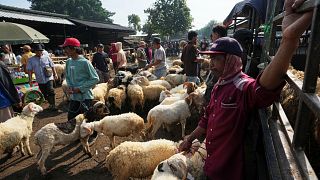Niger
From one moment to the next, they can appear on the straight horizon. Long lines of silhouettes making their way through the desert, the strongest in front, the weakest behind.
Every week, hundreds of migrants who have been turned back from Algeria come to Assamaka, the first village on the border with Niger. There are now more than 4,500 of them wandering around this tiny, windswept island of land.
Malians, Guineans, Ivorians, Syrians, Bangladeshis... After a 15 km walk in the desert, the expellees discover a new purgatory.
The transit center managed by the International Organization for Migration (IOM), the main intergovernmental organization in this field, is overwhelmed by the influx and only takes in about a third of the deportees.
"When we arrived here, we were told that we are not recognized as IOM migrants and therefore we only have to pay for our transportation back home," said Abdoul Karim Bambara, an Ivorian.
In Assamaka, the water tanks are empty, the rations insufficient and the shelters too rare, while the temperature sometimes approaches 48 degrees during the day. Thousands of people are crammed against walls or under makeshift tarpaulins to find a spot of shade.
Stripped of all their belongings in Algeria, according to their testimonies, the refouled can neither call their relatives nor pay for the return trip. They are then condemned to survive in this sand prison for an indefinite period of time, often several months.
-"Cattle"-
Some are doctors, students, traders. But around the barbed wire walls of the center, there are no more individuals. Just a crowd rumbling and jostling to scream out their despair, their scabies-infested skins, their infected wounds, their empty bellies and their ingrained traumas. And the end of all humanity. "We have become cattle!" rants Herman, an Ivorian migrant.
"Did you see that!" a man interrupts him, pointing to a handful of sticky rice infested with flies. "Can you eat that? You get sick from that!".
Away, two groups of hungry people throw stones at each other in a cloud of dust. The brawls are incessant. A few days earlier, the death of a Cameroonian migrant provoked a riot that was dispersed by tear gas. The IOM transit center was attacked and looted by the protesters.
"We are all traumatized. People can't control themselves, there's something wrong with their heads, nothing is right here! People are dying!" raged Aboubacar Cherif Cisse, a native of Sierra Leone.
If there was enough to eat people would not fight, but there is no food, so what can they do? If they have nothing, they will fight, just to survive," assures Mohamed Mambu, delegate of the Sierra Leoneans at the transit center of Arlit.
The 1,500 inhabitants of Assamaka are overwhelmed by this uncontrollable neighborhood. "They are everywhere in the village, near the health center, under the walls," said François Ibrahim, representative of the local NGO Alarme phone Sahara, which provides first aid to migrants in the desert.
The migrants "steal the animals of the population to slaughter them. It is not because they are the thieves, but when the belly is hungry ..." he laments.
- "Unprecedented" -
The number of migrants rejected at the gates of Niger has not stopped increasing since the beginning of the year. A situation "without precedent" according to Doctors Without Borders.
From the Algerian border to Agadez, the regional capital located 350 km away, the transit centers are all clogged. The roads leading further south are under threat from jihadist groups, forcing expensive charter flights to repatriate migrants to their countries of origin.
"The flights are often cancelled (...) But every week there are expulsions," explains Ousmane Atair, manager of the Arlit transit center for IOM.
Located in northern Niger, the Agadez region pays the price of relative stability. "The Assamaka-Arlit axis is the most secure, which is why all the migratory flows are directed to this side," emphasizes the mayor of Arlit, Abdourahamane Maouli.
But international aid is mobilized elsewhere by other security and humanitarian crises. IOM's main donor in the region is the European Union, which funds most of the flights bringing migrants back to their countries of origin.
For Alarme phone Sahara, "the IOM plays a key role in the policy of outsourcing borders on African soil by the European Union states", anxious to keep the migratory pressure away from the Old Continent.
Since the outbreak of the Libyan crisis in 2011, "Agadez is the last door, and it was necessary to secure the journey of all these asylum seekers. But in reality, it was an airlift to discourage them," says Tari Dogo, secretary general of the regional council of Agadez, who sums up a feeling widely shared in the region: "The European Union has its share of responsibility in this situation.











Go to video
Nearly 200 migrants intercepted off the coast of Senegal
01:27
More than 1,200 migrants arrive in Crete amid influx from Libya
01:09
Seven dead as migrant boat capsizes in Spain's Canary Islands
Go to video
Kinshasa reacts to Trump's claim that 'many' Congolese come to US
01:36
Migration and refugee policies key to economic growth, Say UN and IMF experts
03:06
Nigeriens frustrated by ongoing fuel shortage